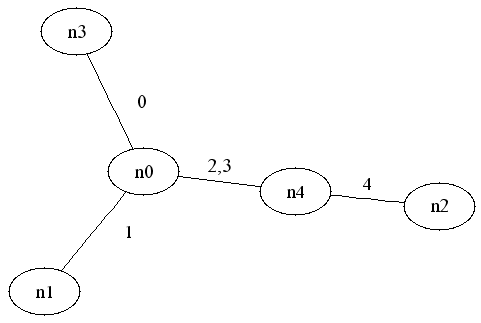| Tel-Aviv university > School of Computer Sciense> Computational Genomics group> GREAL 0.1 |
|
The Graph Realization problem: Graph Realization is the problem of
constructing a tree from a set of its edge-labeled paths. More formally,
Given subsets P1,..Pn of {0,..,m-1}, find a tree T=(V,E)
with E={0,..,m-1} such that every Pi is a path in T, or determine
that no such tree exists. |
||||||||||||||||||||||||||||||||||||||||||||||||
About GREAL: GREAL is an implementation of the algorithm for
Graph Realization of Gavril and Tamari [1]. This algorithm
runs in O(nm2)time and O(nm) space. |
||||||||||||||||||||||||||||||||||||||||||||||||
An example:For the ground set {0,1,2,3,4}and the subests P1={1,2,3,4},P2={0,2,3} and P3={0,1}, the graph realization is:
Notice that we merge a path of dependent edges into one edge, such as 2 and 3 in this example. Edges are dependent if they always appear together in P1,..Pn. Using the GREAL input and output formats (see Read Me), the input is the following hypergraph:
It indicates that E={0,..4} and that T must realize the paths {{1,2,3,4},{0,2,3},{0,1}}. This input is given in hypergraph.txt. The output of GREAL is:
The actual vertices list indicates that this labeling of E should be changed such that 0 remains 0, 1 remains 1, 2 is replaced by 2,3; and 3 is replaced by 4. The tree drawn above is a result of running neato on this output of GREAL. For more details see the Read Me file. For a more complex example of a hypergraph see hypergraph.txt. |
||||||||||||||||||||||||||||||||||||||||||||||||
References: |
||||||||||||||||||||||||||||||||||||||||||||||||
| [1] F. Gavril and R. Tamari (1983) An algorithm
for constructing edge-trees from hypergraphs. Networks, 13:377-388
[2] W. T. Tutte (1958) A homotopy theorem for matroids I and II. Transactions of the American Mathematical Society, 18:144-174 [3] W. T. Tutte (1960) An algoritm for determining whether a given binary matroid is graphic. Proceedings of the American Mathematical Society, 11:905-917 [4] R. E. Bixby and D. K. Wagner (1988) An almost linear-time algorithm for graph realization. Mathematics of Operations Research, 13:99-123 [5] Gusfield D (2002) Haplotyping as Perfect Phylogeny: Conceptual Framework and Efficient Solutions. Proceedings of the Sixth Annual International Conference on Computational Biology (RECOMB '02), 166-175 [6] http://www.research.att.com/sw/tools/graphviz/ |
|
|
| Contact us: Tamar Barzuza,Itsik Pe'er |
|
|
